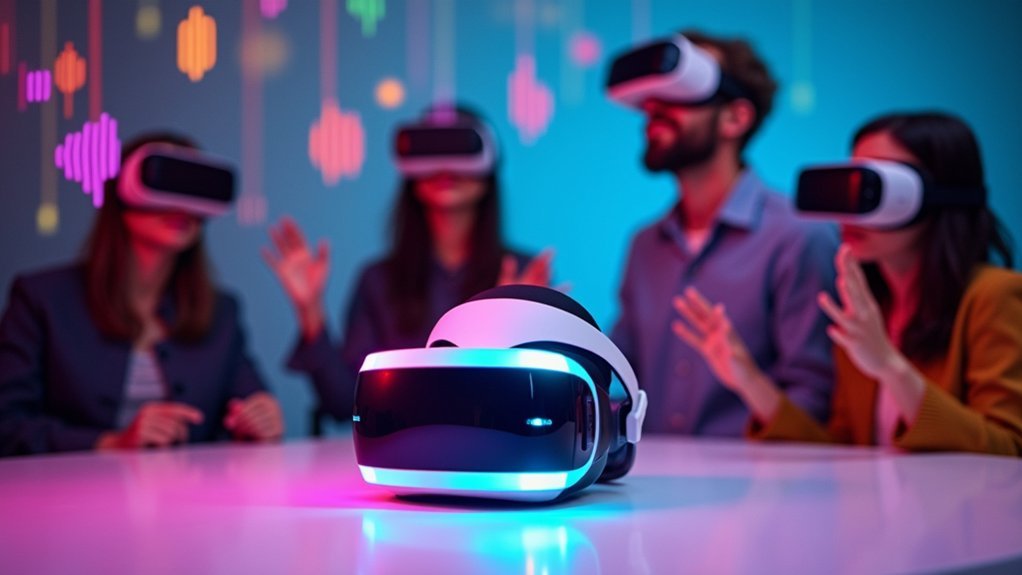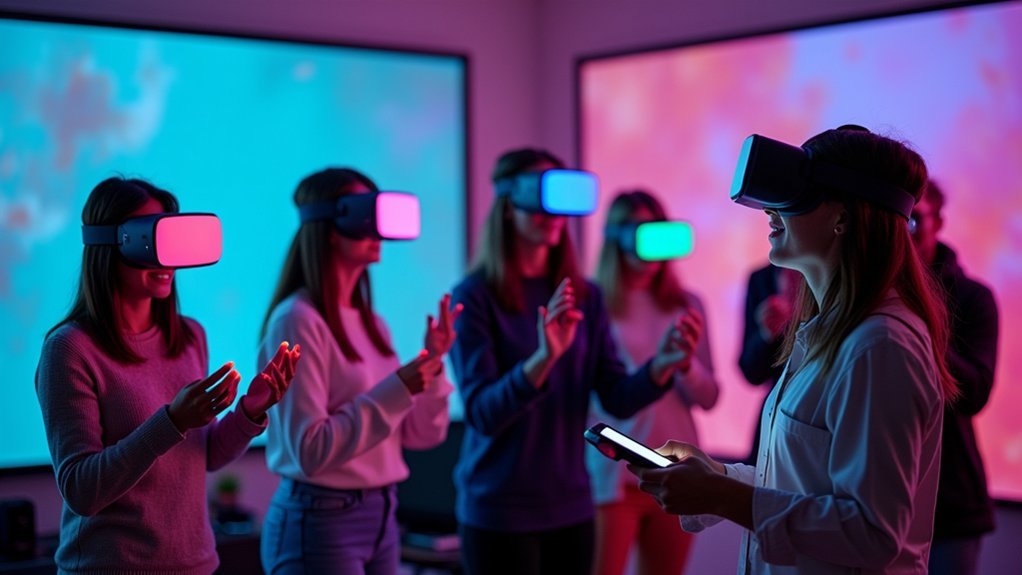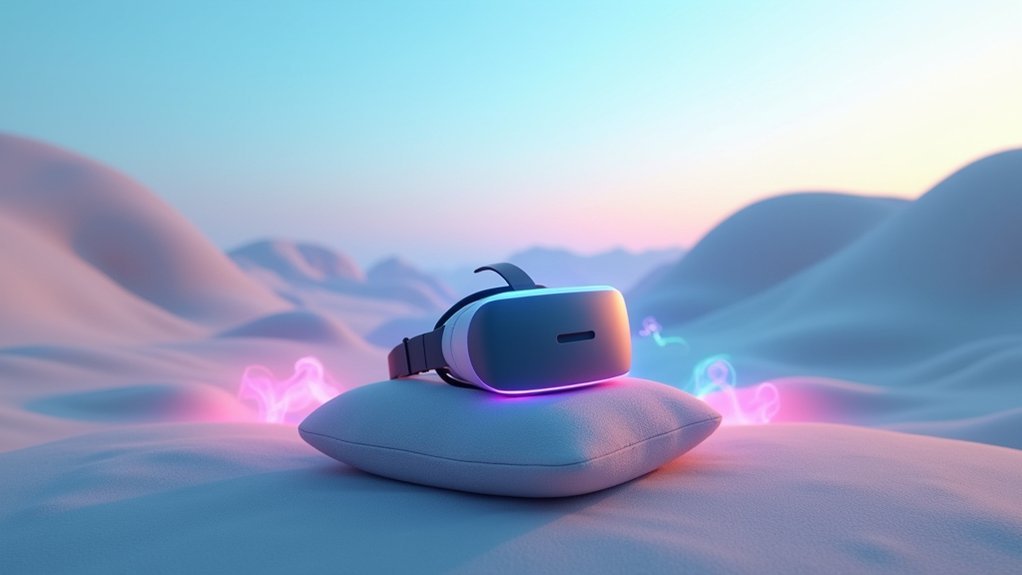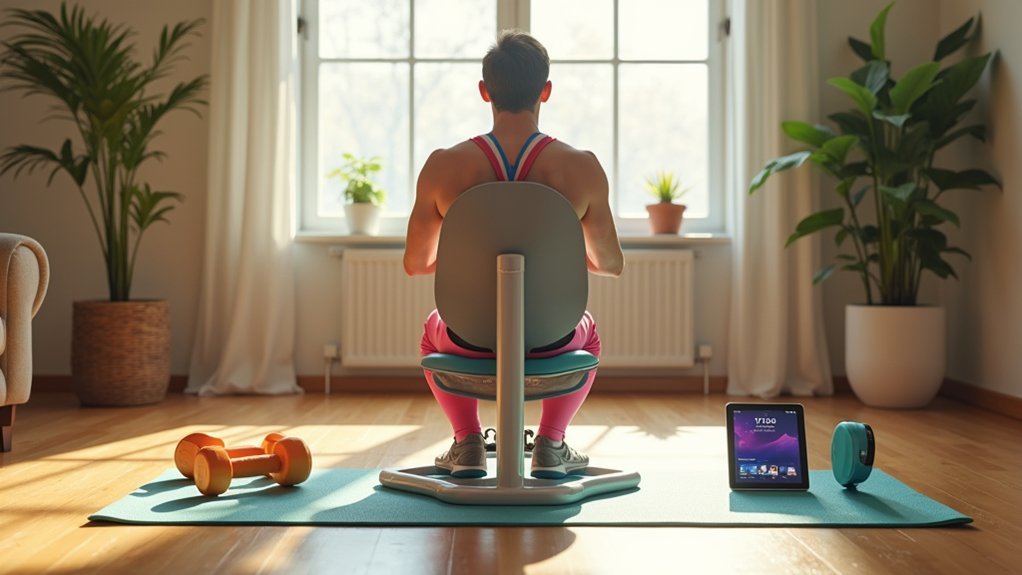You’ll need VR applications with scrolling captions, customizable subtitle settings, and gesture-based interfaces to navigate virtual worlds effectively with hearing disabilities. Look for games like Cook-Out: A Sandwich Tale and AltspaceVR that offer clear visual instructions and automated captions. Maintain 90+ fps frame rates and use teleportation locomotion to prevent motion sickness, especially since 70% of deaf users also experience vestibular disorders. This all-encompassing approach guarantees you’ll discover every essential feature for an ideal accessible VR experience.
Understanding VR Accessibility Challenges for Deaf and Hard of Hearing Users

While VR technology promises immersive experiences for all users, deaf and hard of hearing individuals face substantial barriers that limit their access to virtual worlds. You’ll encounter significant communication challenges when VR platforms rely heavily on audio cues and spoken interactions.
Since you may depend on lipreading, maneuvering through virtual environments becomes particularly difficult when avatars don’t accurately represent facial movements or when lighting conditions are poor.
You’ll also discover that approximately 70% of deaf children with sensorineural hearing loss experience vestibular disorders, which can intensify motion sickness and disorientation in VR.
Additionally, many platforms aren’t accessible to people who need captions, as they lack automatic captions or clear indicators of available accessibility features. When captions exist, they’re often poorly implemented with pop-in formats rather than preferred scrolling text.
Essential Captioning Features in Virtual Reality Applications
How can effective captioning transform your VR experience from frustrating to fully immersive? Vital captioning features in Accessible VR applications focus on readability and seamless integration.
You’ll find scrolling captions more effective than pop-in varieties, as they provide smoother visual flow. Quality timing and contextual relevance are essential for maintaining engagement during your immersive sessions.
Vacation Simulator exemplifies best practices with transparent captions that follow your view, while Moss offers headlocked captions that reduce vestibular discomfort. These captioning features allow you to read dialogue and instructions at your own pace, considerably enhancing comprehension.
The industry needs standardized captioning preferences across platforms. When developers prioritize consistent caption display methods, you’ll enjoy better accessibility regardless of which VR application you’re using.
Visual Communication Solutions Beyond Traditional Audio

You’ll find that effective VR accessibility extends far beyond basic captioning through innovative visual communication methods.
Sign language avatars can translate spoken content into real-time gestures, while advanced caption systems offer customizable display options that reduce motion sickness for users with vestibular disorders.
You can also control your VR environment through gesture-based interfaces that replace traditional audio cues with intuitive visual commands.
Sign Language Avatars
As traditional audio cues disappear in virtual reality, sign language avatars emerge as powerful visual communication tools that transform how deaf and hard of hearing users experience immersive environments.
These sophisticated avatars interpret spoken language into real-time sign language, enabling dynamic conversations within VR spaces. You’ll find that sign language avatars bridge communication gaps on social platforms, creating inclusive interactions between users with different hearing abilities.
When you integrate these accessibility options into your VR experiences, you’ll notice increased engagement and satisfaction among deaf community members. They can finally participate fully in virtual conversations and activities.
Developers should standardize avatar features across applications to guarantee consistency. This standardization enhances your overall experience and creates reliable communication tools you can depend on throughout various VR platforms and environments.
Real-Time Caption Systems
Since VR environments often rely heavily on audio elements, real-time caption systems provide vital visual alternatives that display spoken dialogue as instant text overlays.
You’ll find these systems particularly valuable if you’re deaf or hard of hearing, as they enable full participation in virtual experiences without depending solely on audio cues.
Platforms like AltspaceVR are testing automated captioning features with multi-language support, enhancing social interactions across virtual environments.
You can customize caption appearance through font size and color adjustments, greatly improving readability and engagement levels. These customization options let you tailor viewing preferences to your specific needs.
Real-time caption systems create more inclusive VR environments, especially considering that 70% of deaf users with sensorineural hearing loss also experience vestibular disorders, making effective visual communication essential.
Gesture-Based Interface Controls
Gesture-based interface controls transform how you navigate VR environments by replacing audio-dependent interactions with intuitive hand movements and visual cues.
These systems recognize various hand gestures and expressions, enabling you to communicate effectively in social VR platforms without relying on sound. You’ll receive visual feedback and instructions instead of audio-based guidance, making virtual experiences more accessible for hearing loss.
Customizable gesture settings let you tailor controls to your specific preferences and comfort levels.
This personalization becomes especially important since 70% of deaf and hard of hearing children with sensorineural hearing loss also experience vestibular disorders.
Managing Vestibular Disorders and Motion Sickness in VR

You’ll need to understand that vestibular disorders and hearing loss often occur together, with roughly 70% of deaf and hard of hearing children experiencing both conditions simultaneously.
Your VR experience can quickly become uncomfortable due to motion sickness caused by the mismatch between what you see and what your inner ear senses.
That’s why implementing motion sickness prevention strategies and comfort rating systems becomes essential for creating accessible VR environments that won’t leave you feeling dizzy or nauseous.
Understanding Vestibular-Hearing Connection
While most people don’t realize the inner ear controls both hearing and balance, this connection becomes critically important when designing accessible VR experiences.
When you have hearing impairments, you’re greatly more likely to experience vestibular disorders. Research shows 70% of deaf and hard of hearing children with sensorineural hearing loss face vestibular challenges affecting their balance and spatial orientation.
Your vestibular system works alongside your auditory system within the same inner ear structure.
When hearing loss occurs, especially through conditions requiring cochlear implant surgery, your balance perception can become compromised. This creates a double challenge in VR environments where visual motion cues must compensate for both reduced auditory input and potentially impaired vestibular function, making you more susceptible to motion sickness and disorientation.
Motion Sickness Prevention Strategies
Since hearing and vestibular impairments often occur together, you’ll need targeted strategies to prevent motion sickness in VR environments. Here are proven techniques to reduce discomfort:
| Strategy | Implementation |
|---|---|
| Frame Rate | Maintain 90+ fps to sync head motion with virtual environments |
| Movement Method | Use teleportation instead of smooth locomotion |
| Camera Control | Limit 360° video movement and add fade shifts |
| Exposure Time | Start with short sessions, gradually increase duration |
| Input Settings | Adjust sensitivity and remap controls for comfort |
These approaches specifically address the vestibular-visual mismatch that triggers motion sickness. You’ll find teleportation particularly effective since it eliminates the disconnect between physical stillness and virtual movement. Building tolerance through gradual exposure helps your vestibular system adapt to virtual environments over time.
Comfort Rating Systems
Although mitigation strategies can reduce motion sickness, comfort rating systems provide an essential safety net by helping you identify VR experiences that match your vestibular tolerance levels before you begin.
These neutral third-party rating systems offer clear indicators of comfort levels for each VR experience, enabling you to make informed decisions about which apps to try.
You’ll benefit most from platforms that include search filters for comfort ratings, allowing you to quickly find experiences suited to your needs.
This is particularly important since 70% of deaf and hard of hearing children with sensorineural hearing loss also have vestibular disorders.
When choosing VR content, look for apps with minimal motion ratings, as developers who prioritize comfort typically design experiences that won’t exacerbate your vestibular challenges.
Best VR Apps and Games With Built-In Accessibility Features
Cook-Out: A Sandwich Tale excels with clear visual instructions that guide gameplay effectively.
For social interaction, AltspaceVR offers beta multi-language automated captions, making group experiences more inclusive.
However, avoid apps like Facebook’s Workroom where shaky visuals compromise usability.
Poor visual stability in VR applications can severely undermine user experience and accessibility, making them unsuitable for practical use.
These Accessible Virtual Reality solutions demonstrate how VR helps bridge communication gaps.
Sign Language Integration and Avatar Communication Tools
Beyond visual cues and captions, VR platforms now integrate sophisticated sign language features that transform how deaf and hard of hearing users communicate. Advanced sensor gloves and motion capture technology translate your gestures into digital representations, enabling natural conversations through customizable avatars.
| Technology | Function |
|---|---|
| Sensor Gloves | Capture precise hand movements |
| Motion Tracking | Translate gestures to avatars |
| Avatar Customization | Personalize digital representation |
| Real-time Processing | Instant gesture recognition |
| Community Feedback | Refine integration tools |
These sign language integration tools let you express yourself comfortably during social VR interactions. Your avatar performs accurate sign language gestures, addressing traditional audio-based communication challenges. Developers actively seek community feedback from users with hearing impairments to refine these tools, ensuring they meet diverse needs within the deaf community.
Customizing VR Settings for Optimal Hearing Accessibility
You’ll find that tweaking your VR settings can dramatically improve your hearing accessibility experience.
Start by adjusting audio output customization to balance dialogue, sound effects, and background noise according to your specific needs.
Don’t forget to configure caption display settings and motion comfort controls, as these work together to create a more inclusive virtual environment.
Audio Output Customization
When you’re setting up your VR system for ideal hearing accessibility, audio output customization becomes your most powerful tool for creating a comfortable and clear listening experience.
You’ll want to adjust volume levels, equalization, and balance between different sound sources to achieve optimal clarity.
Enable spatial audio settings to help distinguish where sounds originate within virtual environments, making navigation easier.
Focus on speech clarity by isolating vocal frequencies, which greatly improves dialogue comprehension.
You can disable background noise to concentrate on essential sounds without ambient distractions.
Most importantly, connect your Bluetooth hearing aids or assistive listening devices seamlessly to your VR platform for a truly personalized auditory experience.
Caption Display Settings
How can you guarantee that captions in your VR experience are perfectly tailored to your reading preferences and visual needs?
You’ll want to customize your caption display settings to maximize accessibility and enhance your VR experience. Start by adjusting font size, color, and background options to improve readability based on your specific requirements.
Enable automatic captions across all VR apps by default, ensuring consistent access to spoken content without repeatedly configuring individual applications.
Choose between scrolling and pop-in caption styles to match your reading speed and preferences.
Look for VR apps that provide clear instructions and easy access to caption display settings within their interface.
Consider connecting a Bluetooth keyboard to navigate and interact with these accessibility features more effectively, giving you greater control over personalizing your virtual reality experience.
Motion Comfort Controls
Beyond caption customization, motion comfort controls play an essential role in creating an accessible VR environment for users with hearing impairments. You’ll need to minimize rapid movements and reduce sensory overload, which can trigger vertigo when your auditory balance system is compromised.
| Control Type | Function |
|---|---|
| Movement Speed | Reduces velocity of virtual locomotion |
| Turning Options | Snap turning vs. smooth rotation settings |
| Field of View | Limits peripheral motion visibility |
| Comfort Zones | Creates stable reference points |
| Motion Intensity | Adjusts acceleration and deceleration rates |
These motion comfort controls help you maintain spatial orientation when visual cues become your primary navigation tool. You can customize settings to match your specific needs, ensuring that movement tracking doesn’t overwhelm your remaining senses or create discomfort during extended VR sessions.
Social VR Platforms With Real-Time Caption Support
What happens when you’re deaf or hard of hearing and want to participate in a bustling virtual meetup? Social VR platforms are stepping up with real-time captioning solutions.
AltspaceVR leads this charge, offering automated captioning in multiple languages during beta testing. These captions help bridge communication gaps for users with hearing impairments, though you might experience vertigo when reading while socially interacting.
AltspaceVR’s multilingual automated captioning breaks down communication barriers for deaf users, despite potential vertigo from reading during virtual interactions.
The immersive caption design attempts to blend seamlessly into virtual environments, but comfort remains a challenge. You’ll need to balance reading captions with engaging in conversations and activities.
While the technology isn’t perfect yet, it represents significant progress toward inclusive virtual spaces. As these platforms refine their captioning systems, you can expect improved readability and reduced motion discomfort during social interactions.
Hardware Considerations for Users With Hearing Aids and Cochlear Implants
When selecting VR hardware, you’ll need to verify compatibility with your hearing aids or cochlear implants since electromagnetic interference can disrupt their functionality.
Research headset specifications to ascertain they won’t interfere with your devices’ operation. Prioritize VR systems that support Bluetooth connectivity for seamless audio integration, allowing your hearing devices to connect directly to the headset’s audio output.
Pay attention to the headset’s physical design, particularly around the ear area. Choose models that won’t create uncomfortable pressure points when worn alongside your hearing aids or implants during extended sessions.
Look for adjustable audio settings within the VR platform that let you customize sound levels and frequencies to match your specific hearing needs. These customizable options guarantee you’ll experience clear, comfortable audio tailored to your individual requirements.
Developer Guidelines for Creating Inclusive VR Experiences
Since creating truly inclusive VR experiences requires intentional design choices from the ground up, you’ll need to implement extensive accessibility features that serve users with varying degrees of hearing loss. Start by incorporating automatic captions into your VR operating systems with customizable preferences across all applications. You’ll make virtual reality more accessible by clearly specifying when your games offer audio and text instruction methods, plus voice commands alternatives.
| Feature | Implementation |
|---|---|
| Caption System | Automatic with customizable preferences |
| Comfort Rating | Neutral third-party assessment system |
| Search Filters | Caption availability and comfort ratings |
| Input Support | Bluetooth keyboards and voice commands |
Include search filters for comfort ratings and caption availability, while supporting Bluetooth keyboards to enhance user interaction with VR environments.
Assistive Technologies and Third-party Accessibility Tools
While traditional hearing aids and cochlear implants already transform how users experience audio, integrating these assistive technologies directly with VR systems creates unprecedented opportunities for immersive accessibility.
You’ll find that modern VR platforms can seamlessly connect with your existing hearing devices, amplifying spatial audio and enhancing directional sound cues.
Third-party accessibility tools greatly expand your options beyond built-in features. Automatic captioning software provides real-time text translations of audio content, while customizable subtitle settings let you adjust caption size, color, and position to match your preferences.
Sign language avatars offer an immersive visual communication alternative when you prefer signing over reading text.
Consider exploring databases that catalog VR applications with robust accessibility features, helping you discover experiences specifically designed with assistive device compatibility and extensive captioning systems.
Future Innovations in Hearing-Accessible Virtual Reality
Building on today’s accessibility solutions, emerging technologies promise to revolutionize how you’ll experience VR content in the coming years.
Advanced captioning systems will integrate real-time speech recognition and multi-language translation, dramatically enhancing your hearing-accessible virtual reality experience.
You’ll benefit from haptic feedback technology that converts audio cues into tactile vibrations, improving navigation and situational awareness.
Machine learning algorithms will customize your soundscapes based on your specific hearing loss, optimizing clarity during rehabilitation exercises.
Virtual avatars using real-time sign language will transform social VR communication for deaf users.
Industry-wide captioning standards are being established to guarantee consistent quality across all platforms, ensuring reliable accessibility regardless of which VR application you choose.
Frequently Asked Questions
Is VR Good for People With Disabilities?
You’ll find VR beneficial if you have disabilities because it creates controlled, immersive environments for rehabilitation. You can practice essential skills safely while receiving real-time feedback that adapts to your specific needs.
Who Should Not Use Virtual Reality?
You shouldn’t use VR if you’ve severe vertigo, epilepsy, or seizure history. Avoid it with significant visual impairments, severe cognitive disorders, or extreme motion sickness that VR’s accessibility features can’t accommodate.
Is There a VR That Doesn’t Require a Phone?
You can use standalone VR headsets like the Meta Quest 2 or Quest Pro that don’t require phones. They’ve got built-in processors, storage, and operating systems, letting you download apps directly.
What Two Things Do You Need for a VR Experience?
You need a compatible VR headset like the Oculus Quest 2 for immersive experiences, and a smartphone or computer to download and manage VR applications through platforms like the Oculus app.





Leave a Reply